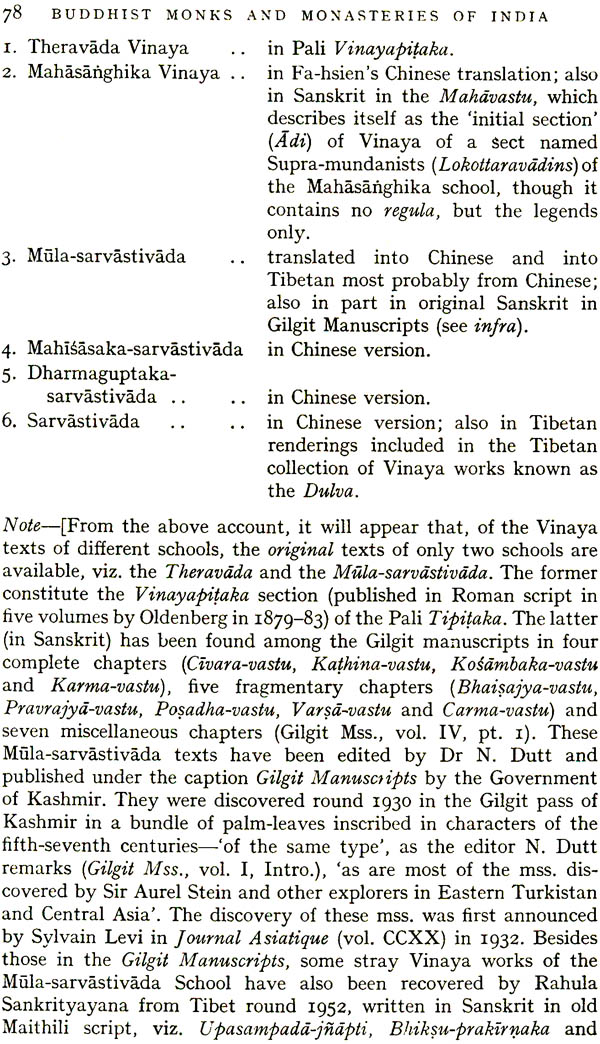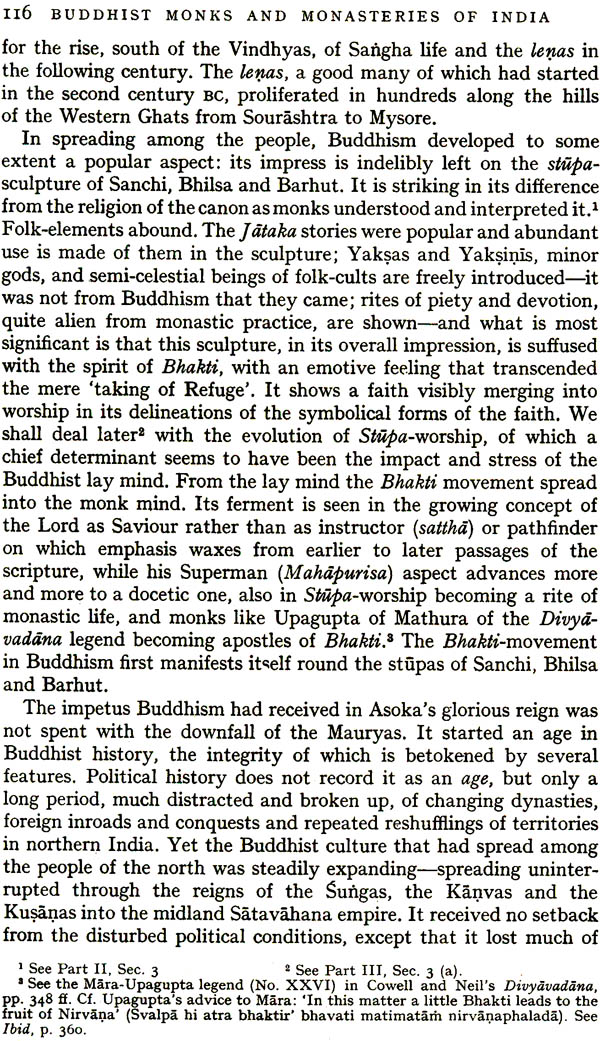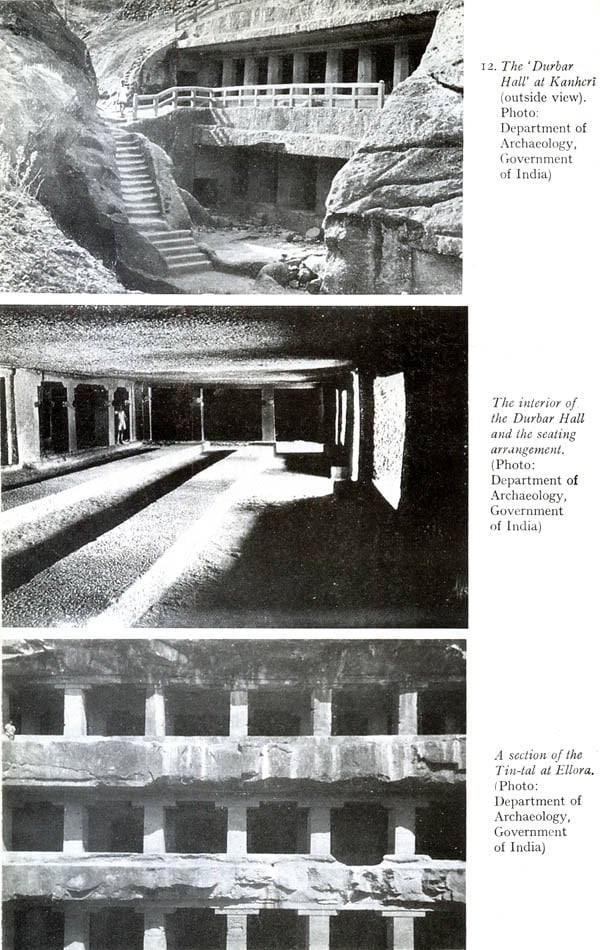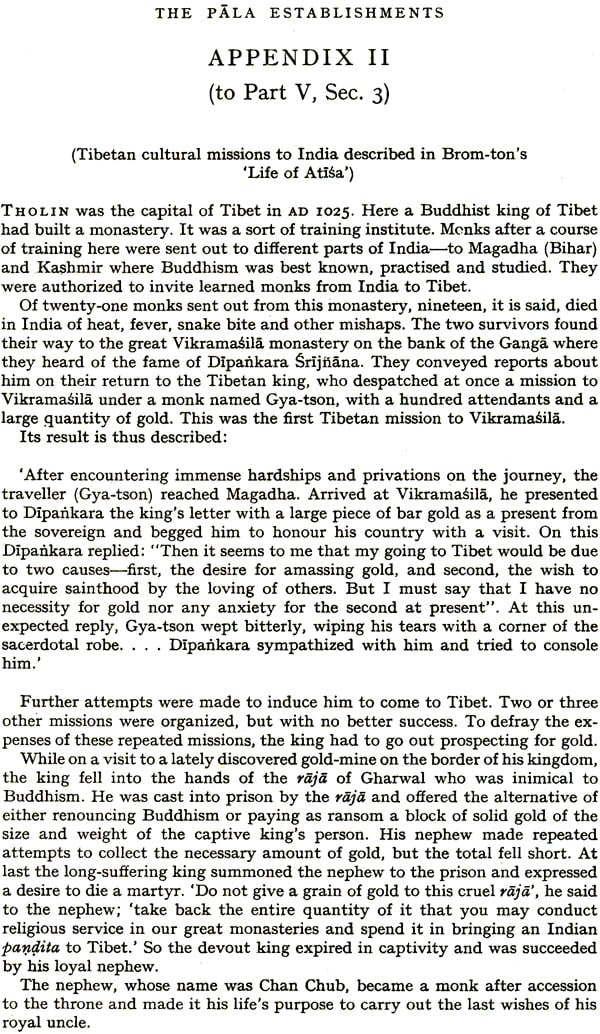
BUDDHIST MONKS AND MONASTERIES OF INDIA (Their History and Their Contribution to Indian Culture)
Book Specification
| Item Code: | IDD463 |
| Author: | SUKUMAR DUTT |
| Publisher: | Motilal Banarsidass Publishers Pvt. Ltd. |
| Language: | English |
| Edition: | 2015 |
| ISBN: | 8120804988 |
| Pages: | 397 |
| Cover: | Hardcover |
| Other Details | 9.8" X 6.7" |
| Weight | 890 gm |
Book Description
About the Book:
Though India is no longer a Buddhist country, Buddhism held its place among Indian faiths for nearly seventeen centuries (500 B.C. - A.D. 1200). During this long stretch of time the Buddhist monks were organized in Sanghas in most parts of the country and their activities and achievements have profoundly influenced India's traditional culture.
There are monumental remains of Buddhist monastic life scattered all over India: in the south there are about a thousand cave-monasteries, among them Ajanta, world-famous for its exquisite mural paintings; in the north, less spectacular, the ruins of monastic edifices from Taxila in the west to Paharpur in the east.
A connected history of the Buddhist monks of ancient India, their activities, their monastic establishments and their contributions to Indian culture, is available for the first time in this work, which is remarkable also for its pervading human interest.
In reconstructing the history of the emperors and kings who were patrons of Buddhism, the early missionaries and the illustrious monk-scholars of later times, the author has used sources in four languages - Pali, Sanskrit, Chinese and Tibetan.
About the Author:
DR. SUKUMAR DUTT (M.A., Ph. D. ) was a reputed Buddhist scholar whose previous works include Early Buddhist Monachism and The Buddha and Five After-Centuries.
Experts from reviews:
The book gives a detailed description of the various stages of development of these monasteries. A great contribution of these monks was the thousands of manuscripts of Buddhist literature they produced. They were carried into distant countries like Tibet and China, studied and translated and preserved. The book provides valuable historical information on the various aspects of Buddhist monasticism.
FR. JOHN B. CHETHIMATTAM CMI.
Journal of Dharma, Sept. 1991.
The book has been made precious by the rare illustrations, numbering twenty-four. It has been printed elegantly, without printing errors, the paper, the get-up, binding, and total production are of a very high order.
DR. R.L. VARSHNEY,
The Vedic Path, Vol. 11, Nos. 2-3,
Sep. - Dec. 1988.
Preface
The SANGHA (Buddhist Monkhood) has received hitherto far less than its due measure of importance in extant studies on Buddhism. The Sangha originated in India: its history in this country, where Buddhism is now extinct as an institutional religion,” is the history of the growth, progress and organization of a great culture that is interwoven in its historic culture-complex.
A sketch of primitive Sangha life and organization was attempted by me in my youth in the book, Early Buddhist Monachism, published in Trubner’s Oriental Series, so far back as in 1924. In the preface to its recently published Indian edition (Asia Publishing House, Bombay, 1960), I have called attention to its inevitable lack and limitation:
‘The book presents a picture in outline of the Buddhist Monastic Order in its growth and development during the first three or four centuries of Buddhism. The need remains yet for a longer dynamic view and more extended historical perspective, for the Buddhist Sanghas, whose early evolution is the theme of this book, continued to function in this country, especially in the east and the south, for many more after centuries. The great monastic universities in the east like Nalanda, Vikramsila, Odantapura and Jagaddala represent the last fine efflorescence of Buddhist monachism, and they were wiped out only towards -the close of the twelfth century by the fanatic violence of the Muslim invaders of Bengal and Bihar."
The object of the present work is to supply this ‘longer dynamic view and more extended historical perspective'.
The work has entailed concentrated research work over two and a half years and could not have been undertaken but for the generous encouragement and active support of Dr Malalasekera, renowned Buddhist scholar of Ceylon, recently ambassador for his country in Moscow. It was through his initiative that a Senior Research Fellowship of the University of Delhi was awarded to me enabling me to carry through this work and also making available to me the ripe scholarship of Professor P. V. Bapat, then Head of the Department of Buddhist Studies in the University. His suggestions and corrections, supplemented by Dr V. V. Gokhale’s, were very helpful for which I remain grateful.
My source-materials come under two main categories-—literary and archaeological.
The literary materials had to be gathered from four languages, Sanskrit, Pali, Chinese and Tibetan. For helping me in the last two, I am indebted to Miss Lalita Lahiri of Lady Irwin School, New Delhi, who studied Chinese for several years in Peking and provided me with translations from Chinese, and to Dr Lokesh Chandra and Lama Chimpa of the International Academy of Indian Culture, New Delhi, for translations from Tibetan.
For the archaeological materials, I had not only to investigate the reports and memoirs of the Archaeological Survey of India, but also to-- make extensive field-studies of archaeological sites where monastic caves and remains of ancient monasteries still exist. In describing or tracing the history of the monasteries, I have had in j several instances to draw upon my own personal knowledge gathered on the spot. I am grateful to the officers of the Archaeological Department, especially to Mr Ghosh, Director-—General, and Dr Patil, Deputy Director—General, for providing me with liberal facilities for my field-study as well as for a sheaf of useful photo- graphs. Dr Moreswar Dikshit (now working in the Madhya Pradesh) was kind and generous enough to lend me an unpublished work of his and allow me to draw from it some materials for which acknowledgement has been made in the book in due place.
I am indebted also to my talented daughter, Miss Krishna Dutt, MSc, for the preparation of the Index, a task of great labour willingly shouldered by her, and to Mr Indra Varma for the maps and sketches included.
In writing this book, it was not the scholar and specialist that I had exclusively in view. The subject is likely to interest today the educated public in our country. Curiosity about our ancient Buddhist past is now more widely diffused. Visitors by hundreds who go to see the famous monastic caves of western India, Ajanta, Kanheri, Pandulena, Karle, etc. and the monastic remains of northern India at Nalanda, Sarnath, Sanchi, Rajgir and other sites will derive a new zest from some knowledge of their historical background and l some idea of the part these monasteries played in our ancient life and culture.
A reconstruction of the history of the Buddhist Sangha in India has, so far as I am aware, not been attempted yet. I have had to break new ground which seemed at places nearly intractable for the lack of reliable historical data. If those scholars to whose critical judgement I must leave this work be in a position to say that this humble attempt at historical reconstruction has been worthwhile, I shall deem my labours amply repaid.
BUDDHISM, now extinct in India as a formal and institutional religion, has a history in this country spanning nearly seventeen centuries (fifth Bc-twelfth AD). It is not the mere history of a faith, though it has been approached too often from this viewpoint only.
Taking Buddhism solely as an ‘-ism’, just a form of faith or system of religion, its history has been sought to be traced through its doctrines and philosophies, its sects and schools, its affinities and inter-connections with other Indian systems of faith or philosophy. This, however, is an introvert view: what it fails to take in is that aspect of the religion which related it most closely to the life of the people-—the aspect that is seen in the organization of its monkhood (Sangha) and the functioning of its monasteries (Viharas). It is the cultural aspect of the religion which is perhaps historically and sociologically more significant.
Culture has been defined by scientists in various terms: over a hundred and sixty definitions are listed in a critical review by Kroeber and Kluckhohn. But the simplest, broadest and pithiest one is by the eminent American anthropologist, Henry S. Coon, who identifies culture with the ‘sum-total of things people do as a result of having been so taught.
India had in the past a culture that took its ‘teachings’ from Buddhism-one extraordinarily long -lived and widespread, that endured over a millennium and a half, spread in its flourishing periods within that wide span of time from end to end of the country. lt has left its vestiges scattered all over the land in what are now `archaeological remains’.
Except for a struggling forlorn existence in a few obscure localities, the Buddhist religion, along with its monk-organization, the Sangha, was extinct in nearly all parts of India over eight hundred years ago. It had been before that in a state of lingering decline for several centuries. The causes of this decline are complex and obscure and still await exploration. What comes, however, into comparative clearness is that Hinduism in its various forms that is placed Buddhism had amalgamated with itself many of its later developments and finally accepted its divine Founder into its own pantheon.
But the culture Buddhism had ‘taught’ and the monkhood and monasteries it propagated undoubtedly survived: in fact, it re- mains to this day a vital functioning part of our cultural heritage. It was inevitable, however, that with the extinction of Buddhism as an organized institutional religion this Buddhist culture should lose its form and contour—no longer recognizable by its Buddhist affiliation} Yet we are made aware in subtle ways how much of its substance remains as ‘crypto—Buddhism’ in our cultural complex- for a little delving below the surface reveals it in certain orientations of our philosophy, valuations in our ethics, even in some of the institutes of indigenous law.2 Less tangibly it inheres and persists in our outlook on life and our attitude towards its problems.
The Buddhist culture cannot be disposed of as a mere historical phenomenon in our culture-history: it has been borne along by the stream of its continuity and is part of its continuum. The history of this culture is bound up with the history of the Sangha.
The SANGHA has a two—fold meaning in Buddhism——‘an entire monk—fraternity’ or 'the bond of association among monks', referring in the former to a ‘body of persons’ and in the latter to the ‘confederation which makes them one body’. As we shall presently observe, both concepts of the Sangha, concrete and abstract, appear in usage. In the Creed of the Three jewels (Tri-ratna), the parity in which the Sangha is placed with the Buddha and the Dhamma is meaningful: it forbids the facile half—baked notion that it represents in Buddhism only the organized missionary agency of a proselytizing faith. The Sangha is differently conceived in the system. In fact a comprehension of the triune concept of the creed is essential in our approach to its history. The concept is vitally correlated not merely to the nature of the Sangha’s functioning, but it sets the course of its evolution and pre-conditions its history.
In the very nature of the religion and in the form it first appeared in, was implicit the bond that binds the Buddha, the Dhamma and the Sangha together in the creed.
Buddhism has been presented too often in manuals and learned treatises as a system of thought and doctrine. The paradox of it is that it was not as an ‘—ism’ that it was first given to the world: it was conceived not as a system to be posited but as a message to be preached.
A system has no inner necessity to be propagated, but Buddhism had—and a pointer to this is the well-known scriptural legend that became the nidus of the doctrine, far-reaching in its consequence, of the Samma-sambuddha and the Pacceka-sambuddha.
The legend describes how the Founder, having received in his Bodhi (spiritual cognition) the Highest Truth and in virtue of it become the Buddha, passed on to a higher stage of attainment as the Samma-sambuddha (‘Teacher of all men'). Unique in this attainment among all the ‘enlightened ones' of the world, he is singled out under this character by the Buddhist as the object of highest adoration.
Yet, as an Upanisad says: ‘From the bliss of the highest truth (Brahamananda) speech recedes, along with all activities of the mind. One who has attained to this bliss becomes therefore a Mauni (Silent One’). But the Founder of Buddhism became not a Mauni, but a Sattha (Teacher). This translation from a Buddha to a Sattha is attributed by the ancient maker of the legend to external adventurious causes the intercession of Brahma Sahampati, the vision of the miseries of all ‘unenlightened’ creatures, and the upsurge of compassion (Karuna) in his heart. Read between the lines, it is a symbolical way of stating that the realization dawned upon the Buddha that the truth received by him had a dynamic quality; it) had need to be converted into a message——and that otherwise, in the static form of Knowledge received and kept by the recipient, it was incapable of fruition or fulfilment. What _this ‘truth’ itself was cannot be known by anybody except him who cognized it: ‘only the Buddha understood Buddhism? The ‘Deathless’ (Amata) was the name he gave to it when he turned it in to a message and cast it in the form of a Dhamma to bring it within average human under- standing. The recipient of the truth had to be a Sattha: the conviction rings sharp and clear in the trumpet-call of the` First Sermon: ‘Give ear! The Deathless (Amata) has been realized by me; I will instruct—I will teach the Dhamma.
Passages of the early (Theravada) scripture show that the faith and message delivered to the disciples and the first monk-followers was regarded by them not as a ‘system’, but as a way of life or form of self-culture: a Dhamma whereby one could bring to cessation all sorrows that arise from the life of the world and the flesh.3 It is described as a Way (Magga), and those to whom the Way has been opened——the initiate, the ordained, the ‘Knowledgeable'—are en- joined to extend it to the Bahujanna (Man in the many). This is the apt collective term taken in the scripture to connote men in general or mankind. The Religion must become Bahujanna (adjectival form of Bahujanna): that was one of the conditions, fulfilment whereof was desiderated by the Buddha before he could think of passing into the ‘Great Decease’.
So the credal formula, in the correlated concepts of the Buddha as the Teacher, the Dhamma as the sum and effect of his teachings and the Sangha as the instrument by which the Dhamma, becoming bahujanna, fulfils itself, epitomizes and rounds off the whole cycle of the faith.
Some western scholars have expressed the view that Buddhism is a religion ‘for the monkhood’ and that the laity was ‘on its fringes’.“ The warrant for this view is certain trends in the Theravada scripture which represent the monk-community as the sole custodian of the religion and draw in respect of participation in the Dhamma a dividing line between monks and lay people} But the sequestration of the religion for the ordained receives scant support, as will be pointed out later, from the Founder’s own canon-reported utterances. Buddhism throve and made headway in India as a religion of the people-a religion that was 'bahujanna'-not as the cult of a sect or a practice of monkhood.
In its progress and expansion through the long centuries, it continually annexed to itself the culture and art, the traditions and folk-lore, the pieties and emotions of the people. Its history remains incomplete and one-sided unless we bring into integration the two aspects that an exoteric religion must develop in course of its history. ‘So far as such religions are systems of belief merely, they constitute what may be called theoretical or speculative systems: so far on the other hand as they are systems of tribal, national, or voluntarily associated life, they may be styled historic or concreted. The history of the Sangha presents this ‘historic’ or ‘concrete’ aspect of the religion. Yet the Sangha in Buddhism has also an abstract aspect in which it is regarded as a spiritual entity.
‘The Sangha could not accept gifts, nor sanctify nor enjoy them and gifts made to the Sangha could bring no reward’: this was the view of an ancient sect of Buddhists, noted in passing in the Kathdvatthu.2 Those who in after times used to make gifts to the Sangha, expecting spiritual benefit for themselves, their families and their relatives, recognized in the conventional formula of their donatory inscriptions this abstract character of the Sangha.3 The gift was first dedicated to the ideal Sangha and the pecuniary endowment was next put ‘in the hand of’ the real Sangha, the actual beneficiary. In the Tri-ratna creed this ideal sense of the Sangha is taken: it stands there, not for a particular society or body of persons, but for the great confederation of the faithful. From the historian's point of view, however, the Sangha represents an Institution.4 The story of the growth, development and functioning of this Institution in India, of which the following pages attempt a broad outline, has a clear beginning, a middle and an end—an integration and unity of interest. A brief recapitulation here of some of its principal aspects and peculiar features may help towards a clearer grasp of the historical perspective.
The milieu in which it was founded was the ancient community of India’s wandering almsmen. It was this milieu that shaped and conditioned it-settled its ethos and basic character, the foundation upon which its own system of Vinaya was afterwards built. But we shall see how the Sangha separated itself from the parent community by its own modification and specialization of a general custom, Vassdvcisa (Rain-retreat), observed by wandering almsmen. This was the starting point from which, outside the wanderers’ community, its evolution commenced, leading it through several stages and ‘varieties of being’.
The wandering Sect became a settled Order; the unitary Sangha became plural; with the spread of Buddhism, the monk—communities, each called a Sangha, went on steadily multiplying till they were spread wide over all parts of the country; in their life and organization gradual changes of a transforming character came about through the action of inner and outer forces; and in the final phase of this history, we see a number of monastic establishments functioning as seats and centres of scholarship and learning, and a few as far—famed ‘universities’. It is a long and chequered history: yet not the history of a static institution, but one that shows remarkable dynamism and capacity for progress.
The monasteries, from where this Institution functioned, have also a long story of growth by stages. The primitive monk-settlement is represented by the "dvdsa or the drdma. A typical monastery, called at first a leiza, came into existence when the primitive Sangha split up into a number of monk-fraternities (Sanghas). Unlike the dvdsa or the dnima, a lem: was not a settlement of monks from all quarters, but accommodated a single fraternity. Originally there were five structural types of lezia, but only two types have survived—the Vihdra and the Guha. Taking the Vindhyan range as the ‘Great Divide’ of India, the Vihdra may be said to be the typical monastery to its north and the Guha to its south.
| PREFACE | 9 | |
| NOTES ON THE TEXT | 15 | |
| INTRODUCTION | 19 | |
| PART I: THE PRIMITIVE SANGHA (500-300 BC) Origin, Development and Organization | ||
| 1. | 'Wandering Almsmen' in the Upanisads | 35 |
| 2. | The BHIKKHU-SANGHA as a Sect among the Wanderers | 45 |
| 3. | From Wandering to Settled Life | 53 |
| 4. | Early Monk-settlements - AVASAS and ARMAS | 58 |
| 5. | Sangha Life and its Organization in Early Settlements | 66 |
| 6. | The Rise of Monasteries (LENAS) | 92 |
| PART II: THE ASOKA-SATAVAHANA AGE (250 BC -AD 100) AND ITS LEGACY | ||
| 1. | Monks of the 'Eastern Tract' | 101 |
| 2. | Asoka and Moggaliputta Tissa | 107 |
| 3. | Early Buddhist Culture and its Trans-Vindhyan Expansion | 118 |
| 4. | An Aftermath of Satavahana Culture - NAGARJUNAKONDA | 126 |
| 5. | Cave - Monasteries (LENAS) of Western India | 138 |
| 6. | The BAGH CAVES | 162 |
| PART III: IN THE GUPTA AGE (AD 300 - 550) AND AFTER | ||
| 1. | Sangha Life in Transition | 169 |
| 2. | The VINAYA: its After-history | 171 |
| 3. | BHAKTI in Later Buddhism | 179 |
| 4. | Monastaries under the Gupta Kings | 195 |
| 5. | The Devastation | 206 |
| 6. | Survey of Monastic Remains of Northern India | 211 |
| 7. | The Maitraka Monasteries of Valabhi | 224 |
| PART IV: EMINENT MONK-SCHOLARS OF INDIA | ||
| 1. | Sources of Information | 235 |
| 2. | The Hinayana (Theravada) Tradition of Textual Scholarship | 249 |
| 3. | The Mahayana and its Scholastic Tradition | 261 |
| 4. | The ACARYAS and Mahayanist Literature Re-interpretation of the Hinayana | 268 |
| 5. | The ACARYAS | 277 |
| 6. | Contemporaries and Near-contemporaries of Hsuan-tsang and I-tsing | 289 |
| 7. | Indian Monk-scholars in China | 294 |
| APPENDIX - On I-tsing's 'Account of Fifty-one Monks' | 311 | |
| PART V: MONASTIC UNIVERSITIES (AD 500 -1200) | ||
| 1. | From 'Study for Faith' to 'Study for Knowledge' | 319 |
| 2. | Mahaviharas that functioned as Universities The University of Nalanda | 328 |
| 3. | The Pala Establishments | 349 |
| APPENDIX I - On the Order of Succession and approximate Regnal Years of kings of the Pala Dynasty | 354 | |
| a. ODANTAPURA | 354 | |
| B. VIKRAMASILA | 358 | |
| APPENDIX II- Tibetan Cultural Missions to India described in Brom-ton's 'Life of Atisa' | 367 | |
| c. SOMAPURA | 371 | |
| d. JAGADDALA | 376 | |
| BIBLIGRAPHY | 381 | |
| INDEX | 387 |














